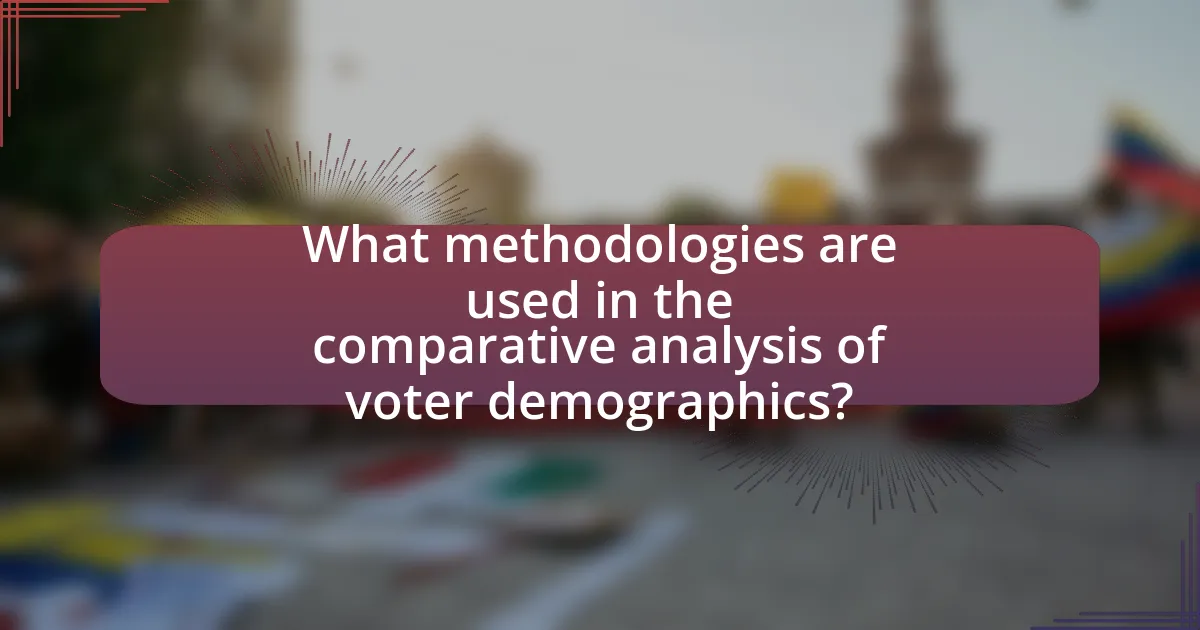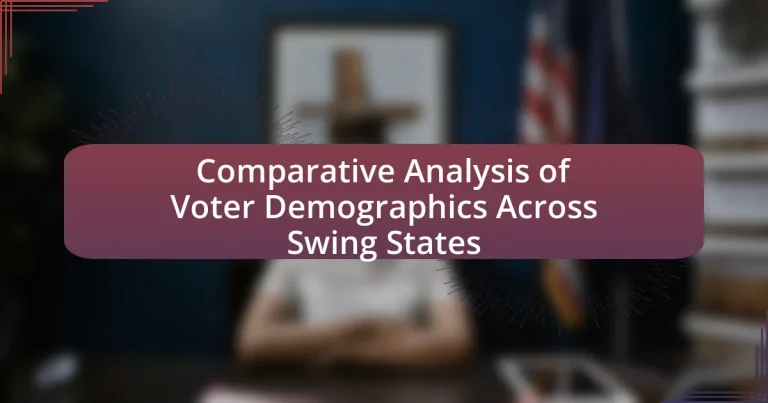The article provides a comparative analysis of voter demographics across swing states, highlighting significant variations in age, race, education, and income levels that influence electoral outcomes. It emphasizes the importance of swing states in elections, as they can be won by either major political party, and discusses how demographic factors such as socioeconomic status, educational attainment, and urban versus rural residency shape voter behavior. The analysis also examines trends in voter turnout among different demographic groups, the impact of historical events on voter demographics, and the methodologies used to collect and analyze demographic data. Key findings indicate that understanding these demographics is crucial for political campaigns aiming to engage diverse voter groups effectively.

What is the Comparative Analysis of Voter Demographics Across Swing States?
The comparative analysis of voter demographics across swing states reveals significant variations in age, race, education, and income levels that influence electoral outcomes. For instance, states like Pennsylvania and Wisconsin show a higher percentage of white voters compared to states like Nevada, which has a more diverse population including a substantial Hispanic demographic. According to the U.S. Census Bureau, in the 2020 election, 56% of voters in swing states identified as white, while 20% identified as Black and 18% as Hispanic, indicating a demographic landscape that can sway election results. Additionally, educational attainment plays a crucial role; states with higher percentages of college-educated voters, such as Michigan, tend to lean Democratic, while those with lower educational attainment, like Ohio, often support Republican candidates. This demographic analysis underscores the complexity of voter behavior in swing states, highlighting how these factors can shift electoral dynamics.
Why are swing states significant in elections?
Swing states are significant in elections because they can be won by either major political party, making them critical for determining the overall outcome. These states often have a mix of voter demographics and political ideologies, which leads to competitive races. For instance, in the 2020 U.S. presidential election, states like Pennsylvania, Wisconsin, and Michigan were pivotal, as they collectively contributed 46 electoral votes, which were essential for Joe Biden’s victory. The fluctuating support in swing states reflects broader national trends and voter sentiments, making them focal points for campaign strategies and resource allocation.
What defines a swing state in the electoral context?
A swing state in the electoral context is defined as a state where both major political parties have similar levels of support among voters, making it a competitive battleground in elections. These states can significantly influence the outcome of presidential elections due to their unpredictability; for instance, in the 2020 election, states like Pennsylvania and Wisconsin were pivotal as they switched from supporting one party in previous elections to the other. The importance of swing states is underscored by their ability to sway electoral votes, as they often determine the overall winner in close elections.
How do swing states influence national election outcomes?
Swing states significantly influence national election outcomes by determining the allocation of electoral votes, as they often have a balanced mix of political affiliations that can sway either way. For instance, in the 2020 presidential election, states like Pennsylvania, Wisconsin, and Michigan were pivotal, as they collectively contributed 46 electoral votes and were won by a margin of less than 2% in many cases. This close competition in swing states means that candidates focus their campaigns on these areas, tailoring their messages to resonate with undecided voters, which can ultimately shift the overall election results. Historical data shows that swing states have consistently played a crucial role in deciding elections, as evidenced by the fact that in the last five presidential elections, the winner of the popular vote did not always align with the electoral vote outcome, highlighting the importance of these key states.
What factors contribute to voter demographics in swing states?
Voter demographics in swing states are influenced by factors such as socioeconomic status, education levels, racial and ethnic diversity, and urban versus rural residency. Socioeconomic status affects voting behavior, as individuals with higher incomes and education levels tend to lean towards specific political parties; for instance, in the 2020 election, voters with college degrees favored the Democratic candidate by a significant margin. Racial and ethnic diversity plays a crucial role, with states like Arizona and Georgia experiencing shifts in demographics that impact electoral outcomes; for example, the growing Hispanic population in Arizona has contributed to a more competitive political landscape. Additionally, urban areas typically exhibit different voting patterns compared to rural regions, with urban voters often supporting Democratic candidates, while rural voters lean Republican, as seen in the 2020 election results where urban centers in swing states showed higher turnout for Democrats.
How do age, race, and gender affect voter turnout in these states?
Age, race, and gender significantly influence voter turnout in swing states. Younger voters, particularly those aged 18-29, tend to have lower turnout rates compared to older demographics, with only about 50% participating in recent elections, as reported by the U.S. Census Bureau. Racial minorities, including Black and Hispanic voters, often face systemic barriers that can affect their turnout, yet when mobilized, they show high engagement levels; for instance, Black voter turnout reached approximately 60% in the 2020 election, according to the Pew Research Center. Gender also plays a role, with women generally voting at higher rates than men; in the 2020 election, 57% of eligible women voted compared to 53% of eligible men, as indicated by the U.S. Census Bureau. These demographic factors interact in complex ways, shaping the electoral landscape in swing states.
What role does education level play in shaping voter demographics?
Education level significantly influences voter demographics by affecting political preferences and turnout rates. Higher education levels are often associated with increased likelihood of voting and a tendency to support more progressive policies. For instance, data from the U.S. Census Bureau indicates that in the 2020 election, 57% of voters with a bachelor’s degree or higher participated, compared to only 43% of those with a high school diploma or less. This trend suggests that educational attainment correlates with greater civic engagement and distinct political alignments, shaping the overall voter landscape in swing states.

How do voter demographics vary across different swing states?
Voter demographics vary significantly across different swing states, influencing electoral outcomes. For instance, in states like Pennsylvania, there is a higher concentration of white working-class voters, while states such as Nevada exhibit a more diverse electorate, with a substantial Hispanic population. According to the U.S. Census Bureau, in 2020, 77% of Pennsylvania’s voters identified as white, compared to 49% in Nevada, highlighting the demographic differences. Additionally, age and education levels also differ; Florida has a larger population of retirees, impacting voting patterns, whereas North Carolina has a younger demographic with a growing number of college-educated voters. These variations in race, age, and education across swing states play a crucial role in shaping political strategies and campaign focuses.
What are the key demographic differences among swing states?
Key demographic differences among swing states include variations in age, race, education, and urban versus rural populations. For instance, states like Florida and North Carolina have significant Hispanic populations, while states like Wisconsin and Michigan have higher percentages of white voters. Additionally, younger voters tend to be more concentrated in urban areas, such as in Pennsylvania and Nevada, which can influence voting patterns. Educational attainment also varies, with states like Virginia having a higher percentage of college graduates compared to others like Ohio. These demographic factors play a crucial role in shaping electoral outcomes, as they influence party affiliation and voter turnout.
Which swing states have the highest diversity in voter demographics?
The swing states with the highest diversity in voter demographics are Florida, Texas, and Nevada. Florida has a significant Hispanic population, particularly from Puerto Rico and Cuba, making it a diverse electoral battleground. Texas is characterized by a large and growing Latino population, alongside a mix of African American and Anglo voters, contributing to its demographic complexity. Nevada’s diversity is driven by a substantial Hispanic community and a significant number of Asian American voters, reflecting its varied electorate. These states exemplify the demographic diversity that influences electoral outcomes in the United States.
How do urban and rural populations differ in their voting patterns?
Urban and rural populations differ significantly in their voting patterns, with urban voters typically favoring Democratic candidates and rural voters leaning towards Republican candidates. This trend is evidenced by data from the 2020 U.S. presidential election, where urban areas, such as cities like New York and Los Angeles, showed over 70% support for Joe Biden, while rural counties predominantly supported Donald Trump, often exceeding 60% of the vote. Additionally, factors such as education levels, economic interests, and social issues contribute to these divergent voting behaviors, with urban voters prioritizing progressive policies and rural voters focusing on traditional values and economic stability.
What trends can be observed in voter demographics over recent elections?
Recent elections have shown a significant shift in voter demographics, particularly with increasing diversity among the electorate. For instance, the 2020 U.S. presidential election saw a notable rise in participation among younger voters and voters of color, with exit polls indicating that 50% of eligible voters aged 18-29 cast their ballots, compared to 36% in 2016. Additionally, the Latino vote increased from 29% in 2016 to 33% in 2020, reflecting a growing influence of this demographic in swing states. Furthermore, suburban areas have experienced a shift towards Democratic candidates, as evidenced by the fact that suburban voters favored Joe Biden over Donald Trump by a margin of 54% to 44%. These trends highlight the evolving landscape of voter demographics, emphasizing the importance of understanding these shifts for future elections.
How have demographic shifts impacted voting behavior in swing states?
Demographic shifts have significantly impacted voting behavior in swing states by altering the composition of the electorate, leading to changes in party alignment and voter preferences. For instance, the increasing diversity in states like Arizona and Georgia, driven by population growth among Hispanic and Black communities, has shifted these states from traditionally Republican to more competitive or Democratic-leaning in recent elections. In the 2020 presidential election, Biden won Georgia with 49.5% of the vote, largely due to increased turnout among minority voters, reflecting a broader trend where demographic changes influence electoral outcomes. Additionally, the aging population in states like Florida has led to a stronger emphasis on issues such as healthcare, affecting voting patterns and party strategies.
What historical events have influenced changes in voter demographics?
The Civil Rights Movement significantly influenced changes in voter demographics in the United States. This movement, particularly through the Voting Rights Act of 1965, aimed to eliminate racial discrimination in voting, leading to increased voter registration and participation among African Americans in the South. Following the Act, the percentage of registered Black voters in Southern states rose dramatically, from approximately 30% in 1964 to over 60% by the early 1970s, fundamentally altering the political landscape and voter demographics in those regions. Additionally, the women’s suffrage movement culminated in the 19th Amendment in 1920, granting women the right to vote and expanding the electorate, which further diversified voter demographics. These historical events illustrate the direct impact of legislative changes on voter participation and demographic shifts.

What methodologies are used in the comparative analysis of voter demographics?
The methodologies used in the comparative analysis of voter demographics include quantitative analysis, qualitative research, and mixed-method approaches. Quantitative analysis often employs statistical techniques such as regression analysis and demographic modeling to assess voting patterns and demographic shifts. Qualitative research, on the other hand, utilizes interviews and focus groups to gain insights into voter motivations and perceptions. Mixed-method approaches combine both quantitative and qualitative data to provide a comprehensive understanding of voter demographics. These methodologies are validated by studies such as the Pew Research Center’s analysis of voting trends, which highlights the importance of demographic factors in electoral outcomes.
How is data collected for analyzing voter demographics?
Data for analyzing voter demographics is collected through various methods, including surveys, census data, and voter registration records. Surveys, such as those conducted by organizations like the Pew Research Center, gather information on voters’ age, race, gender, and political affiliation. Census data, collected every ten years by the U.S. Census Bureau, provides comprehensive demographic information that helps in understanding population characteristics. Voter registration records, maintained by state election offices, offer insights into the demographics of registered voters, including their geographic distribution and party affiliation. These methods collectively enable researchers to analyze and compare voter demographics across different regions, particularly in swing states, where demographic shifts can significantly impact election outcomes.
What sources provide reliable demographic data for swing states?
Reliable demographic data for swing states can be sourced from the U.S. Census Bureau, which provides comprehensive population statistics, including age, race, and income data. Additionally, the Pew Research Center conducts studies that analyze voter demographics and trends, offering insights into the political landscape of swing states. The National Election Pool and Edison Research also provide valuable exit poll data that reflects the demographics of voters in these critical areas during elections. These sources are widely recognized for their accuracy and reliability in demographic research.
How do researchers ensure the accuracy of demographic analysis?
Researchers ensure the accuracy of demographic analysis by employing rigorous data collection methods and statistical techniques. They utilize large, representative samples from reliable sources such as the U.S. Census Bureau and academic surveys to gather demographic information. Additionally, researchers apply statistical methods like weighting and stratification to adjust for biases and ensure that the sample reflects the population accurately. For instance, the American National Election Studies (ANES) provides comprehensive data that researchers use to analyze voter demographics, ensuring that findings are representative of the broader electorate. This combination of reliable data sources and advanced statistical techniques reinforces the validity of demographic analyses in understanding voter behavior across swing states.
What analytical techniques are employed in this comparative analysis?
The analytical techniques employed in this comparative analysis include statistical modeling, regression analysis, and demographic segmentation. Statistical modeling allows researchers to identify patterns and relationships within voter data across swing states. Regression analysis is utilized to assess the impact of various demographic factors on voting behavior, providing insights into how different groups may influence election outcomes. Demographic segmentation further categorizes voters based on characteristics such as age, ethnicity, and income, enabling a more nuanced understanding of voter preferences and trends. These techniques collectively enhance the robustness of the analysis by providing a comprehensive view of voter demographics and their implications in swing states.
How do statistical models help in understanding voter behavior?
Statistical models help in understanding voter behavior by quantifying relationships between demographic factors and voting patterns. These models analyze data such as age, income, education, and ethnicity to predict how different groups are likely to vote in elections. For instance, a study by the Pew Research Center found that statistical analysis of voter demographics can reveal significant trends, such as younger voters leaning more towards progressive candidates compared to older voters. By employing regression analysis and other statistical techniques, researchers can identify key influences on voter decisions, enabling political campaigns to tailor their strategies effectively.
What role does data visualization play in presenting demographic findings?
Data visualization plays a crucial role in presenting demographic findings by transforming complex data into accessible visual formats that enhance understanding. Visual representations, such as charts and graphs, allow for quick comparisons and identification of trends within demographic data, making it easier for stakeholders to grasp significant patterns. For instance, a study by the Pew Research Center found that visual data presentations can improve retention and comprehension of information by up to 80%, demonstrating the effectiveness of visualization in conveying demographic insights.
What implications do the findings have for future elections?
The findings indicate that understanding voter demographics in swing states will significantly influence campaign strategies in future elections. By analyzing shifts in voter preferences and turnout rates among different demographic groups, political parties can tailor their messaging and outreach efforts to resonate more effectively with key populations. For instance, data from the 2020 election revealed that suburban voters, particularly women, played a crucial role in determining outcomes in battleground states like Georgia and Arizona. This trend suggests that future campaigns must prioritize issues that matter to these demographics, such as healthcare and education, to secure their support.
How can political campaigns leverage demographic insights from swing states?
Political campaigns can leverage demographic insights from swing states by tailoring their messaging and outreach strategies to resonate with specific voter segments. For instance, analyzing data from the U.S. Census Bureau reveals that swing states often have diverse populations with varying socioeconomic backgrounds, education levels, and cultural values. By understanding these demographics, campaigns can create targeted advertisements and policy proposals that address the unique concerns of different groups, such as young voters, minorities, or working-class families. This approach has been validated by the success of campaigns that utilized micro-targeting techniques in the 2020 election, which demonstrated that personalized communication significantly increased voter engagement and turnout in key demographics.
What strategies can be developed to engage diverse voter groups?
To engage diverse voter groups, targeted outreach strategies must be developed that address the unique needs and concerns of each demographic. These strategies can include culturally relevant messaging, multilingual communication, and partnerships with community organizations that represent specific groups. For instance, research indicates that personalized outreach efforts, such as door-to-door canvassing in neighborhoods with high concentrations of minority populations, can significantly increase voter turnout. Additionally, utilizing social media platforms popular among younger voters can enhance engagement by providing information in formats that resonate with them. Data from the U.S. Census Bureau shows that voter turnout among Hispanic and Black communities can be improved through tailored campaigns that focus on issues like immigration reform and social justice, which are particularly salient to these groups.
What best practices should be followed in analyzing voter demographics?
Best practices in analyzing voter demographics include utilizing comprehensive data collection methods, ensuring data accuracy, and employing statistical analysis techniques. Comprehensive data collection involves gathering information from multiple sources, such as census data, voter registration records, and surveys, to create a holistic view of the electorate. Ensuring data accuracy is critical; this can be achieved by cross-referencing data points and validating them against reliable sources. Employing statistical analysis techniques, such as regression analysis and demographic segmentation, allows for deeper insights into voting behavior and trends. For instance, the U.S. Census Bureau provides detailed demographic data that can be instrumental in understanding voter characteristics and preferences, thereby enhancing the analysis of voter demographics in swing states.
How can researchers maintain objectivity in their analysis?
Researchers can maintain objectivity in their analysis by employing systematic methodologies, such as using standardized data collection techniques and statistical tools. These approaches minimize bias by ensuring that data is gathered and analyzed consistently across different contexts. For instance, utilizing random sampling methods can help ensure that the sample accurately represents the population, thereby reducing selection bias. Additionally, researchers can implement blind analysis techniques, where the data is analyzed without knowledge of the hypotheses being tested, further enhancing objectivity. Studies have shown that these practices lead to more reliable and valid results, as they help mitigate personal biases and preconceived notions that may influence the analysis.
What common pitfalls should be avoided in demographic studies?
Common pitfalls to avoid in demographic studies include relying on outdated data, failing to account for sample bias, and neglecting the context of demographic changes. Outdated data can lead to inaccurate conclusions, as demographic trends can shift rapidly; for instance, the U.S. Census data is updated every ten years, and using older data may misrepresent current demographics. Sample bias occurs when the sample does not accurately reflect the population, which can skew results; for example, if a study on voter demographics only surveys urban areas, it may overlook rural voting patterns. Lastly, neglecting the context of demographic changes, such as economic shifts or migration patterns, can result in misinterpretation of data; understanding the reasons behind demographic changes is crucial for accurate analysis.





